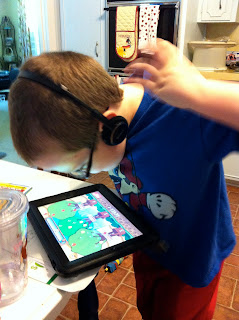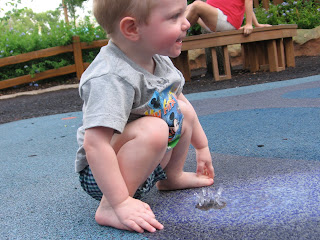When Ryan was a baby, there were times when he held his hand in front of his face and stiffened so much that he shook. I thought that it was a frustration release... maybe his tiny baby hands just wouldn't do what he wanted.
Then came the hand-flapping. When he saw something he liked, he pulled his hands up just behind his ears and twitched, kinda waved, his fingers and hands rapidly. But why in the world would something so adorable be cause for alarm? We certainly didn't see it as a red flag. I mean, look at that face. The glasses so adorable they make puppies look ugly. Really! Tell that kid to stop flapping his hands.
It was right about here, however, when his development slowed. He was a bit of a late walker, but had a handful of phrases at around 8 months! He said something that sounded like "I love 'em" run all together. He said it when we gave him those flavored baby puff things to eat. We even call them "lovems" to this day. But by the time of this picture, that was all gone.
Then came the hand-flapping. When he saw something he liked, he pulled his hands up just behind his ears and twitched, kinda waved, his fingers and hands rapidly. But why in the world would something so adorable be cause for alarm? We certainly didn't see it as a red flag. I mean, look at that face. The glasses so adorable they make puppies look ugly. Really! Tell that kid to stop flapping his hands.
 |
He wanted to spend more time with anything that he could make spin. Eye contact disappeared.
And the hand-flapping revved with more and more intensity, not to mention frequency.
When it was first suggested that Ryan was on the autism spectrum, or that he had a Pervasive Developmental Disorder, we found out that he was sensory seeking. That means what it sounds like. He seeks sensory input. He craves it. I still remember that behavioral therapist from ECI rubbing his legs, arms, feet, and back, and how much Ryan loved him as a result.
It was then that we were told about stimming. When Ryan would flap his hands as something spun around, that was this thing called stimming. To be honest, I didn't really understand it then. I'm not dead sure I understand now. But I do know that it is something vital to my boy of very limited meaningful communicative speech. At seven, he is behind his three year old sister in meaningful communicative speech. We are miles ahead of where we were and where we could be, but still... if you ask him his name, you will likely not get a response.
This (still now) dearly loved behavioral therapist suggested several things that we implemented and still use with our children. He held our hands through the scariest, most heart-wrenching part of the introduction to the idea that our child has autism. But there is one thing he suggested that we tried for a while and couldn't follow through.
Ryan doesn't have quiet hands.
Ryan's hands show his delight at something he loves. They show his fiercest anger. They exhibit fascination at an object, excitement to do something he loves. We have learned, over time and through a desperate desire to know our son, to read his hands. Sometimes his stimming is accompanied by humming. Sometimes he pops up on his toes, humming and hand-flapping with delight. Other times, when his stim becomes more tight, the look on his face more intense, it's time to stop doing what he's doing. There are things, such as elevators, that being allowed to stim to his delight creates some cross of fear and addiction.
It looks odd. It certainly does not look normal! He sticks out in a crowd for sure when he begins to hand-flap and hum. There have been times that we have encouraged him to calm, but usually for just that reason. So he'll be calm. Not to look normal, not to blend in. To stay calm. His new thing is with microwaves. You can't start the microwave in my house without him barreling to the kitchen to watch, stim, and say "Mom turned on the microwave!" The line doesn't come at the sight of stimming. It comes in not indulging him in continuing to start the microwave over and over or hit the button on the elevator just to watch it.
To attempt to stop his stimming completely would be like trying to teach a dog not to wag its tail. Instead of, "Wow mom... this is so COOL!" we see flapping. We hear humming.
When he was a little guy and I was expecting his sister, I asked if he was excited to meet her. He had just reached out to my swollen belly to pat it... a definite first. He immediately hand-flapped hard, and spouted "Save money! Live better! Walmart!"
Then I thought it was just Ryan being his deliciously random self. Now I know that he was telling me, "yes, mom! I can't wait!"
See the hands? In this picture, he's playing iPad and stimming on a new game. Notice how shocked and freaked out Richie and Maelynn are NOT. It's just part of their life. He's their brother, and they adore him. They've tried to stim... to hand-flap... just like him, and it's so sweet.
There's another great shot of him enjoying an iPad game. As far as the scary parts of autism goes, stimming isn't even on the scale. At this point, it's beyond adorable most of the time. In the beginning, it was scary and seemed to be one more thing we were to curb. It was a part of the overwhelming mass of new stuff to do, to avoid, and to work constantly to get him to stop doing.
So many of you have asked over the years what this looks like... and here you go. Maybe someday I'll post a video... or maybe you'll get to see him do it in person. More likely for some of you, a child in the grocery store or at a movie theater will pop up and start flapping in her own way.
And now you know what she's doing.
Thanks be to God for stretching the boundaries of our understanding of everything... right down to the way we communicate!


































